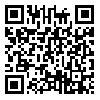BibTeX | RIS | EndNote | Medlars | ProCite | Reference Manager | RefWorks
Send citation to:
URL: http://tumj.tums.ac.ir/article-1-641-en.html
Background: Measuring anxiety level in clinical and non-clinical population needs valid and reliable tool. This research examined the validity and reliability of Beck Anxiety Inventory in Iranian normal population as well as clinically anxious patients.
Methods: First, a two-session course was run to train research workers. After they were sufficiently prepared, they were dispatched to different regions of the city, Tehran, referring to residential places for men and women volunteer to take part in the research. At the end, 1513 respondents were randomly recruited and tested using Beck Anxiety Inventory (BAI). Of this population, 112 respondents were randomly selected and re-tested in order to measure test-retest reliability with a one-month interval time between first and second tests. Meanwhile, 261 clinically anxious patients (from clinics and mental health centers) were tested. In order to measure validity, 150 patients were interviewed by two parallel clinicians and the anxiety level was rated based on a 10-point scale from 0 (the least) to 10 (the most). The two raters were blind to the BAI scores of the patients.
Results: For data reduction and analysis, the SPSS for Windows-edition 14, was conducted. Findings showed that the Persian version of BAI proved a good reliability (r=0.72, p<0.001), a very good validity (r=0.83, p<0.001), and an excellent internal consistency (Alpha=0.92).
Conclusions: The results support the applicability of BAI in Iranian population and suggest the use of this inventory for clinical and research aims. Persian version of BAI not only can help clinicians in assessment and diagnosis, but also assist researchers to evaluate anxiety level when needed.
| Rights and permissions | |
 |
This work is licensed under a Creative Commons Attribution-NonCommercial 4.0 International License. |





